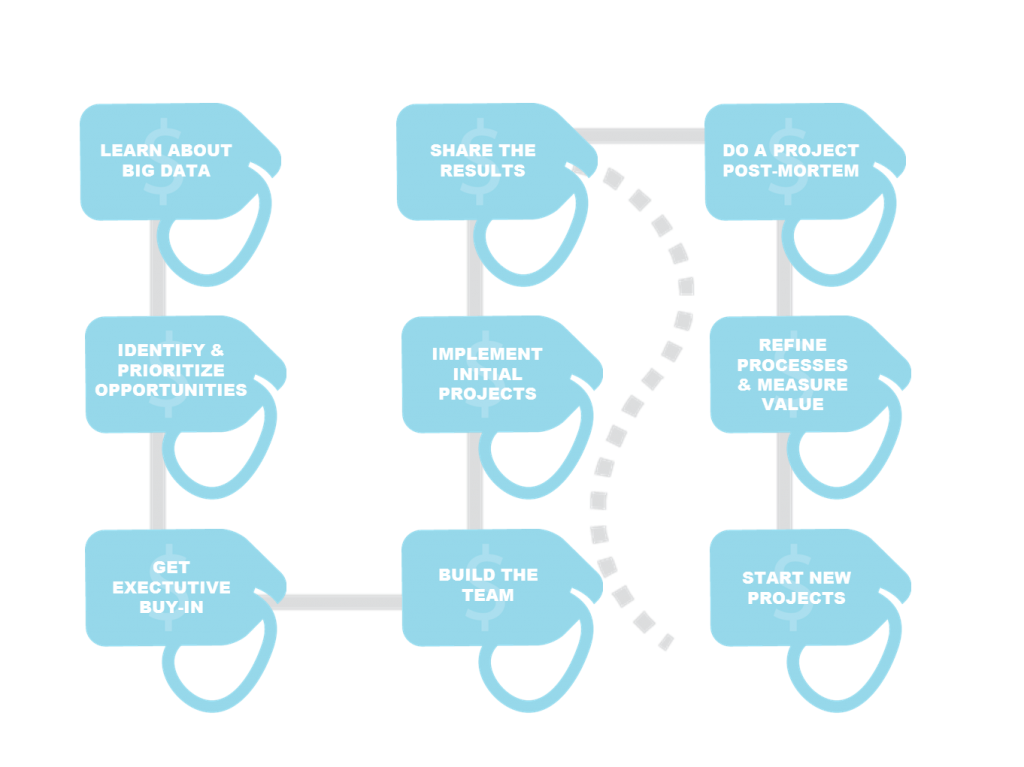A question often asked by marketers about big data is “Where do we start?” For newcomers and seasoned experts alike, there is no shortcut to finding the “signal” in the “noise” of today’s big data. What I recommend is a structured, methodical approach to meet the challenge.
Here is a suggested 9-step road map for those organizations just getting started with big data, or for those who got off to a rocky start and are looking for some course correction.
Learn about big data
Do your homework. Read what others are doing with big data. Attend conferences. Talk to others who’ve both succeeded and failed in their big data initiatives. Research what your competition is doing with big data.
Identify and prioritize opportunities
As your understanding of big data develops, you begin to “see” big data opportunities everywhere – inside and outside your organization. Focus your attention on those opportunities that will provide value to your business. Then systematically prioritize these opportunities, taking into consideration business value, size of effort and technical difficulty.
Get executive buy-in
Many big data projects fail because they skip this step. Despite the outcome of their “skunkworks” project, if the project doesn’t align with executive priorities, its survival may be compromised. Instead, bring your prioritized list of opportunities to management and get their feedback and support.
Build the team
Once executives have approved an initial effort, it’s time to build a multi-disciplinary team. This team may include the following: an executive sponsor, business subject matter experts, IT practitioners, and external resources, as needed. The size and scope of the project will help inform how many should participate.
Implement initial project
Make sure the selected effort is well-scoped. Start small. You’re looking for a quick win to prove that big data is good for the organization. On the flipside, if the project is going to fail, you want to fail fast so that you can move on.
Share the results
Enlist interested parties in reporting the results of your effort. This is true whether the project has succeeded or failed. The accountability is good, and you will most likely garner more support along the way.
Do a project post-mortem
At the end of the project, gather the team together to conduct a project post-mortem. Identify what worked well, what didn’t work and lessons learned. Identify opportunities of improvement for future projects.
Refine processes and measure value
Based on feedback from the project post-mortem and management team, refine processes and adjust the project team accordingly. Depending on the type of project, start measuring the anticipated value.
Start new projects
Now with one big data project under your belt, start the next project, and repeat the cycle of sharing results, refining processes and measuring value.
You’ve just read an excerpt from my recent publication, The Big Data E-book: A Tale of Customer Loyalty and Going SoLoMo. This entertaining e-book tells the story of a struggling marketing executive at Thompson’s Market, one of California’s favorite (fictional) grocery chains. The new CEO wants to up Thompson’s game and better meet their customers where they’re at. It’s going to take big data – of the social, location, and mobile kind – to get them moving in the right direction.
I invite you to download The Big Data E-book to see the road map in action. You’ll also read in more detail how the management at Thompson’s works through identifying and prioritizing their big data opportunities. It’s a fun and interesting approach that may trigger an idea or two for your own organization, regardless of your industry.
“Whatever course you decide upon, there is always someone to tell you that you are wrong.
There are always difficulties arising which tempt you to believe that your critics are right.
To map out a course of action and follow it to an end requires courage.”
~Ralph Waldo Emerson
Let me know what you think. And thank you for following!

